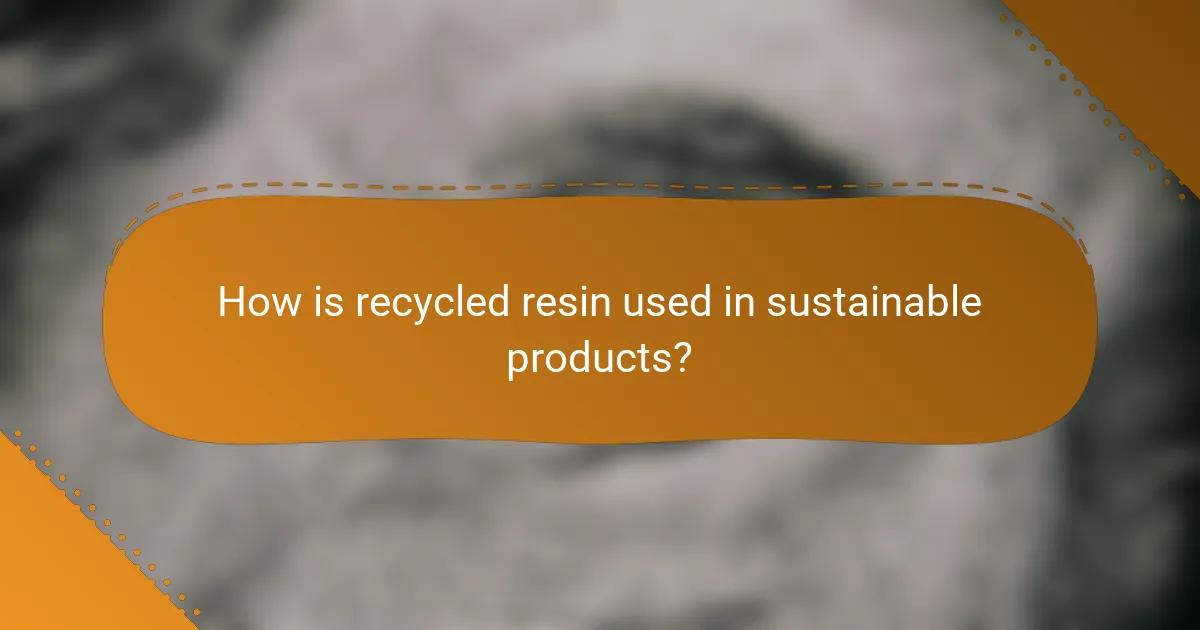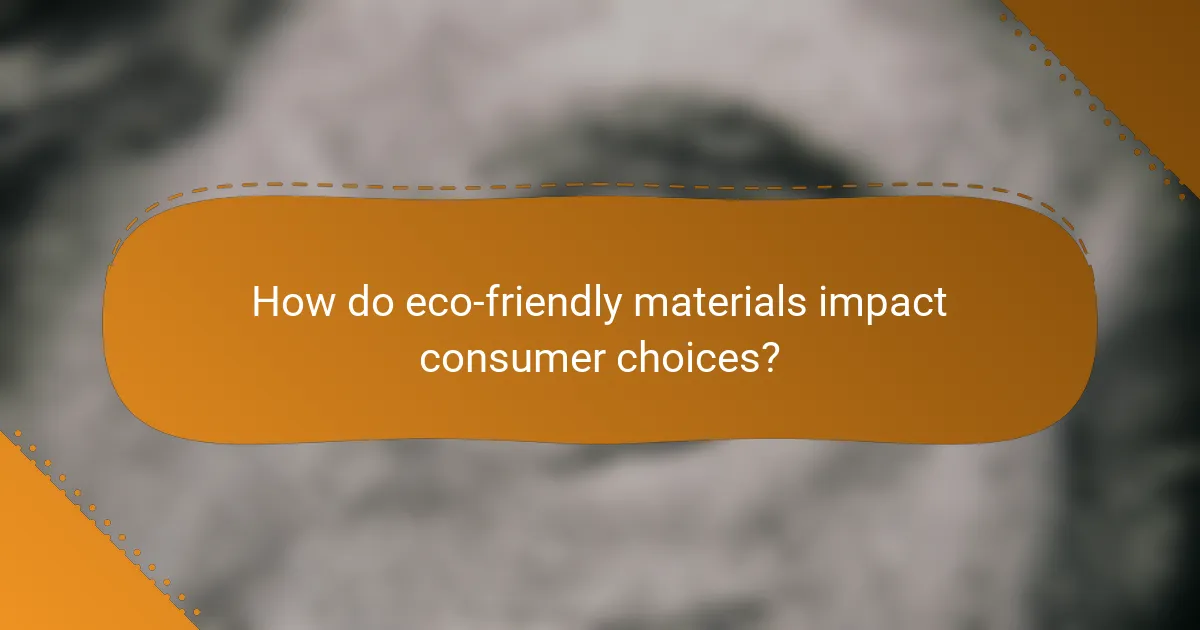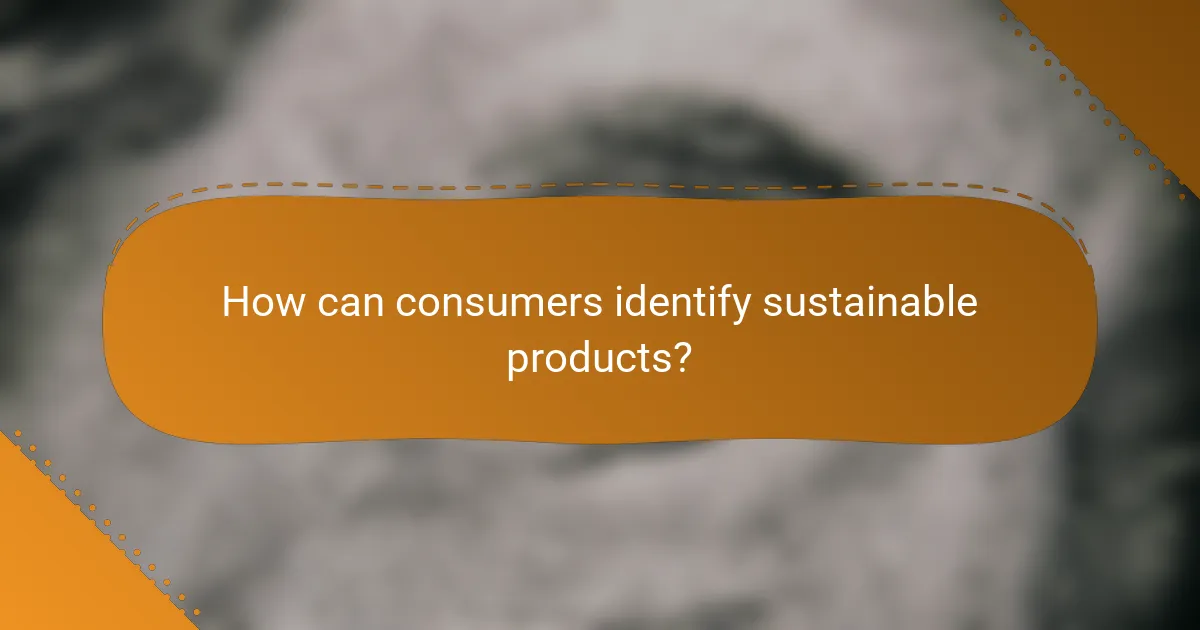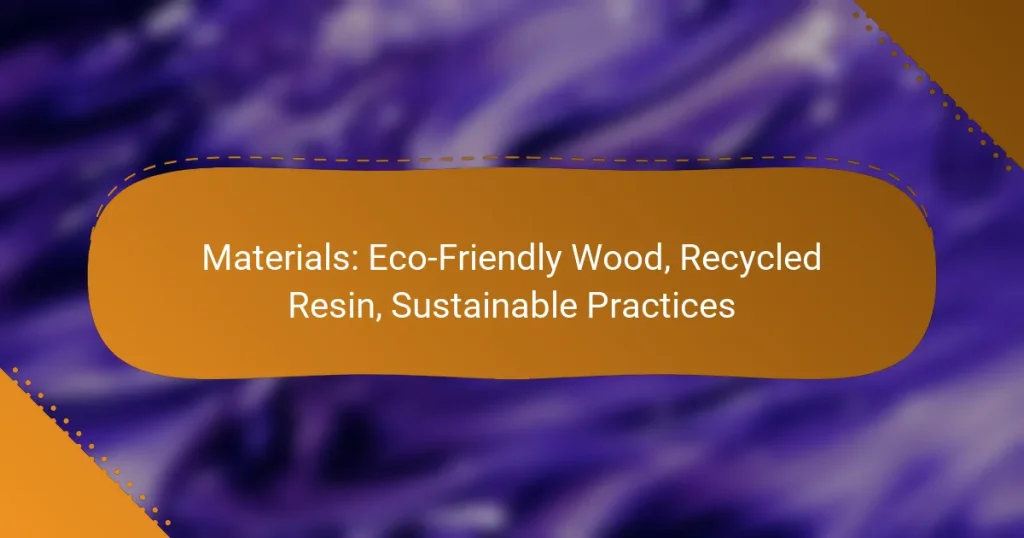In today’s eco-conscious world, the use of eco-friendly wood and recycled resin is essential for sustainable practices. Eco-friendly wood options, such as bamboo and reclaimed wood, promote responsible forestry while reducing environmental impact. Meanwhile, recycled resin repurposes plastic waste into durable products, further minimizing landfill contributions. By adopting these materials and sustainable practices, businesses can significantly enhance their resource efficiency and environmental stewardship.

What are eco-friendly wood options available in the market?
Eco-friendly wood options include materials that are sustainably sourced, such as bamboo, reclaimed wood, and certain types of hardwoods like cedar and teak. These alternatives not only reduce environmental impact but also promote responsible forestry practices.
Bamboo as a sustainable wood alternative
Bamboo is a fast-growing grass that can be harvested in three to five years, making it a highly renewable resource. Its strength and versatility allow it to be used in furniture, flooring, and construction, often outperforming traditional hardwoods.
When choosing bamboo products, look for certifications such as FSC (Forest Stewardship Council) to ensure sustainable practices. Additionally, consider the manufacturing processes to avoid harmful chemicals that can negate its eco-friendly benefits.
Cedar wood benefits for eco-conscious consumers
Cedar wood is naturally resistant to decay and insects, which reduces the need for chemical treatments. This durability makes it an excellent choice for outdoor furniture and structures, contributing to its longevity and sustainability.
Opt for cedar sourced from sustainably managed forests. The Western Red Cedar variety is particularly popular for its aesthetic appeal and aromatic properties, making it a favored choice among eco-conscious consumers.
Teak wood sourced from sustainable plantations
Teak is renowned for its durability and weather resistance, making it ideal for outdoor applications. Sustainable teak is harvested from plantations that adhere to responsible forestry practices, ensuring minimal environmental impact.
When purchasing teak, verify that it comes with certifications such as the FSC label. This guarantees that the wood is sourced from well-managed forests, helping to preserve biodiversity and promote sustainable land use.
Reclaimed wood for environmentally friendly projects
Reclaimed wood is salvaged from old buildings, furniture, and other structures, giving it a second life and reducing the demand for new timber. This option not only minimizes waste but also adds character and history to new projects.
When selecting reclaimed wood, inspect it for quality and potential contaminants. It’s advisable to choose products that have been properly treated and finished to ensure safety and longevity in your projects.

How is recycled resin used in sustainable products?
Recycled resin is increasingly utilized in sustainable products due to its versatility and reduced environmental impact. By repurposing plastic waste, manufacturers can create durable items while minimizing landfill contributions and conserving resources.
Recycled resin in furniture manufacturing
In furniture manufacturing, recycled resin is often combined with wood fibers or other materials to create composite boards and surfaces. This approach not only reduces the need for virgin materials but also enhances the durability and aesthetic appeal of the final products.
Common applications include tabletops, chairs, and cabinetry, where the resin provides resistance to moisture and scratches. Brands focusing on sustainability often highlight the use of recycled resin to attract eco-conscious consumers.
Applications of recycled resin in construction
Recycled resin finds various applications in the construction industry, particularly in insulation, roofing materials, and flooring. These products benefit from the strength and lightweight nature of resin, making them ideal for sustainable building practices.
For instance, recycled resin can be used in composite decking, which offers a long-lasting alternative to traditional wood while reducing deforestation. Additionally, using recycled materials can help builders meet green building certifications, such as LEED.
Benefits of recycled resin for eco-friendly packaging
Recycled resin is a popular choice for eco-friendly packaging due to its lightweight and durable properties. It can be molded into various shapes, making it suitable for containers, bottles, and protective packaging materials.
Using recycled resin in packaging helps reduce plastic waste and lowers the carbon footprint associated with production. Many companies are now adopting recycled resin to align with sustainability goals and appeal to environmentally aware consumers.

What sustainable practices should businesses adopt?
Businesses should adopt sustainable practices that minimize environmental impact while promoting resource efficiency. Key strategies include implementing a circular economy model, sourcing materials sustainably, and utilizing renewable energy in production processes.
Implementing a circular economy model
A circular economy model focuses on reusing materials and products to extend their lifecycle, reducing waste. Businesses can achieve this by designing products for durability, repairability, and recyclability, ensuring that materials are kept in use as long as possible.
To implement this model, companies should assess their supply chains and identify opportunities for reclaiming materials. For example, furniture manufacturers can take back old products to refurbish or recycle them, creating a closed-loop system that benefits both the environment and the business.
Reducing carbon footprint through sustainable sourcing
Sustainable sourcing involves selecting materials that are produced with minimal environmental impact. This can include using eco-friendly wood, recycled resin, or other sustainable materials that reduce reliance on virgin resources.
Businesses should evaluate their suppliers based on sustainability criteria, such as certifications like FSC (Forest Stewardship Council) for wood products. By prioritizing local sourcing, companies can also reduce transportation emissions, further lowering their carbon footprint.
Utilizing renewable energy in production
Utilizing renewable energy sources, such as solar or wind power, in production processes can significantly reduce greenhouse gas emissions. Transitioning to renewable energy not only helps the environment but can also lead to cost savings in the long run.
Companies should consider investing in on-site renewable energy systems or purchasing green energy from local providers. For instance, a manufacturing facility could install solar panels to meet a portion of its energy needs, contributing to sustainability goals while potentially lowering energy costs over time.

How do eco-friendly materials impact consumer choices?
Eco-friendly materials significantly influence consumer choices by aligning product offerings with growing environmental concerns. As more consumers prioritize sustainability, their purchasing decisions increasingly reflect a preference for products made from eco-friendly wood, recycled resin, and other sustainable materials.
Growing demand for sustainable products
The demand for sustainable products has surged as consumers become more environmentally conscious. Many shoppers actively seek out items made from renewable resources, such as eco-friendly wood, which is sourced from responsibly managed forests.
Retailers are responding by expanding their ranges of sustainable options, often highlighting these products in marketing campaigns. This trend is evident across various sectors, including furniture, fashion, and packaging.
Consumer awareness of environmental impact
Increased awareness of environmental issues has led consumers to consider the ecological impact of their purchases. Many individuals now research the materials used in products, opting for those that minimize harm to the planet.
For instance, consumers are more likely to choose items made from recycled resin, which reduces waste and conserves resources. This shift in mindset encourages brands to adopt sustainable practices and communicate their efforts transparently.
Influence of eco-labels on purchasing decisions
Eco-labels play a crucial role in guiding consumer choices by providing recognizable certifications that indicate sustainability. Labels such as FSC (Forest Stewardship Council) for wood products or recycling symbols for plastics help consumers make informed decisions.
Research shows that products with credible eco-labels can boost sales by appealing to environmentally conscious shoppers. Brands that invest in obtaining these certifications often see a positive impact on their reputation and customer loyalty.

What are the certifications for eco-friendly materials?
Certifications for eco-friendly materials help consumers identify products that meet specific environmental and sustainability standards. These certifications ensure that materials are sourced responsibly, manufactured with minimal environmental impact, and contribute to sustainable practices.
FSC certification for sustainable wood
The Forest Stewardship Council (FSC) certification indicates that wood products come from responsibly managed forests that provide environmental, social, and economic benefits. To achieve FSC certification, forests must meet strict criteria regarding biodiversity, ecosystem health, and community rights.
When purchasing FSC-certified wood, look for the FSC logo on products, which ensures that the wood has been harvested sustainably. This certification is recognized globally and is a reliable indicator of responsible forestry practices.
Cradle to Cradle certification for recycled materials
Cradle to Cradle certification assesses products based on their environmental impact throughout their lifecycle, focusing on material health, recyclability, and renewable energy use. Products that achieve this certification are designed to be reused or recycled, minimizing waste and promoting a circular economy.
When selecting Cradle to Cradle certified materials, consider their potential for reuse and the sustainability of their production processes. This certification is particularly relevant for products made from recycled materials, ensuring they contribute positively to the environment.
LEED certification for sustainable building materials
Leadership in Energy and Environmental Design (LEED) certification is a widely recognized standard for green building practices. It evaluates the sustainability of building materials based on factors such as energy efficiency, water usage, and indoor environmental quality.
To achieve LEED certification, building projects must meet specific criteria, including the use of eco-friendly materials. When selecting materials for a LEED-certified project, prioritize those with recognized certifications like FSC or Cradle to Cradle to enhance your project’s sustainability profile.

How can consumers identify sustainable products?
Consumers can identify sustainable products by looking for specific certifications and understanding the materials used in their production. Key indicators include eco-friendly labels, transparency in sourcing, and adherence to recognized sustainability standards.
Reading labels for eco-friendly certifications
Labels featuring eco-friendly certifications provide essential information about a product’s sustainability. Look for certifications such as Forest Stewardship Council (FSC) for wood products, which ensures responsible forest management, or Cradle to Cradle, indicating a product is designed for a circular economy.
When reading labels, pay attention to the criteria for these certifications. Each label has specific requirements that companies must meet, which can include reduced environmental impact, ethical labor practices, and resource efficiency. Familiarize yourself with these standards to make informed choices.
Common certifications include Energy Star for energy efficiency, USDA Organic for agricultural products, and the Global Recycled Standard for recycled materials. Checking for these labels can help you quickly assess the sustainability of a product before purchasing.


